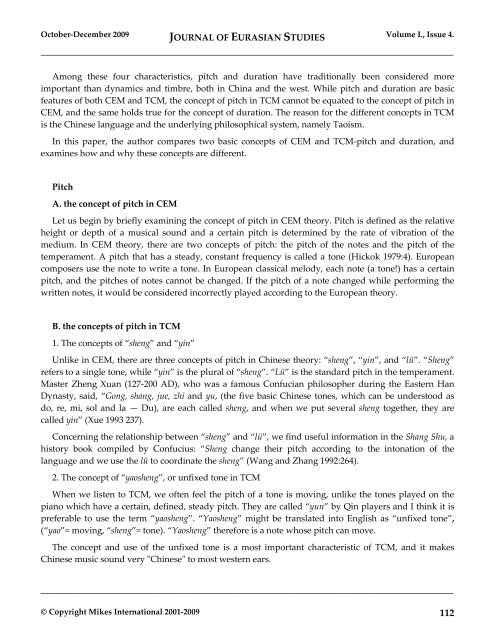JOURNAL OF EURASIAN STUDIES
JOURNAL OF EURASIAN STUDIES
JOURNAL OF EURASIAN STUDIES
Create successful ePaper yourself
Turn your PDF publications into a flip-book with our unique Google optimized e-Paper software.
October-December 2009 <strong>JOURNAL</strong> <strong>OF</strong> <strong>EURASIAN</strong> <strong>STUDIES</strong> Volume I., Issue 4.<br />
_____________________________________________________________________________________<br />
Among these four characteristics, pitch and duration have traditionally been considered more<br />
important than dynamics and timbre, both in China and the west. While pitch and duration are basic<br />
features of both CEM and TCM, the concept of pitch in TCM cannot be equated to the concept of pitch in<br />
CEM, and the same holds true for the concept of duration. The reason for the different concepts in TCM<br />
is the Chinese language and the underlying philosophical system, namely Taoism.<br />
In this paper, the author compares two basic concepts of CEM and TCM-pitch and duration, and<br />
examines how and why these concepts are different.<br />
Pitch<br />
A. the concept of pitch in CEM<br />
Let us begin by briefly examining the concept of pitch in CEM theory. Pitch is defined as the relative<br />
height or depth of a musical sound and a certain pitch is determined by the rate of vibration of the<br />
medium. In CEM theory, there are two concepts of pitch: the pitch of the notes and the pitch of the<br />
temperament. A pitch that has a steady, constant frequency is called a tone (Hickok 1979:4). European<br />
composers use the note to write a tone. In European classical melody, each note (a tone!) has a certain<br />
pitch, and the pitches of notes cannot be changed. If the pitch of a note changed while performing the<br />
written notes, it would be considered incorrectly played according to the European theory.<br />
B. the concepts of pitch in TCM<br />
1. The concepts of “sheng” and “yin”<br />
Unlike in CEM, there are three concepts of pitch in Chinese theory: “sheng”, “yin”, and “lü”. “Sheng”<br />
refers to a single tone, while “yin” is the plural of “sheng”. “Lü” is the standard pitch in the temperament.<br />
Master Zheng Xuan (127-200 AD), who was a famous Confucian philosopher during the Eastern Han<br />
Dynasty, said, “Gong, shang, jue, zhi and yu, (the five basic Chinese tones, which can be understood as<br />
do, re, mi, sol and la — Du), are each called sheng, and when we put several sheng together, they are<br />
called yin” (Xue 1993 237).<br />
Concerning the relationship between “sheng” and “lü”, we find useful information in the Shang Shu, a<br />
history book compiled by Confucius: “Sheng change their pitch according to the intonation of the<br />
language and we use the lü to coordinate the sheng” (Wang and Zhang 1992:264).<br />
2. The concept of “yaosheng”, or unfixed tone in TCM<br />
When we listen to TCM, we often feel the pitch of a tone is moving, unlike the tones played on the<br />
piano which have a certain, defined, steady pitch. They are called “yun” by Qin players and I think it is<br />
preferable to use the term “yaosheng”. “Yaosheng” might be translated into English as “unfixed tone”,<br />
(“yao”= moving, “sheng”= tone). “Yaosheng” therefore is a note whose pitch can move.<br />
The concept and use of the unfixed tone is a most important characteristic of TCM, and it makes<br />
Chinese music sound very "Chinese" to most western ears.<br />
_____________________________________________________________________________________<br />
© Copyright Mikes International 2001-2009 112
















